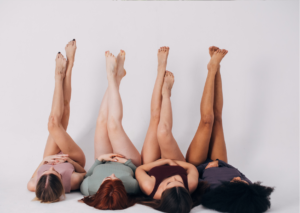Good to know about pre-menstrual syndrome
- 20 to 40 percent of women of childbearing age suffer from PMS.
- PMS manifests itself in both physical and psychological symptoms. The symptoms are as individual as you are.
- You can improve mild symptoms with a balanced diet, exercise and a healthy lifestyle.
- There are five different types of PMS that can be distinguished.
Reading time: about 3 minutes
Do you know this too? Just before your period, you’re suddenly much more irritable and moody. Even the smallest thing makes you either rage or cry. You feel like your body is going crazy. Sounds like a nightmare, or in other words, like premenstrual syndrome. But what is it exactly and how can you alleviate the annoying symptoms?
Premenstrual syndrome – also called PMS – starts about 10 to 14 days before your period. For many women, it can sometimes be really difficult to manage normal daily life with PMS. It is estimated that between 20 to 40 percent of women of childbearing age suffer. A considerable amount, but it also shows that you are not alone. Yet, even today, the topic is still not talked about much, despite the fact that so many women are affected by it. Many women still think that PMS symptoms are normal and simply part of the menstrual cycle. But is this true and how does PMS actually develop?
Causes of premenstrual syndrome
Science does not yet fully know the causes of PMS. However, one of the most common theories is that PMS is caused by an imbalance between the hormones oestrogen and progesterone in the body. An increased sensitivity to hormonal fluctuations can also cause some women to be more sensitive to hormonal changes in the body than others. But genes, stress, lack of exercise or nicotine and alcohol consumption can also increase the symptoms. In the meantime, however, there are many treatment options that can alleviate the typical symptoms.

Most common PMS symptoms
PMS has many symptoms that at first glance have nothing to do with each other. For some women, the symptoms are even so severe that they significantly restrict their everyday life. About 5 percent of those affected also suffer from severe physical discomfort – premenstrual dysphoric disorder, also called PMDS. The most common physical symptoms of PMS include:
- Abdominal pain
- Headaches, difficulty concentrating
- Mood swings, including irritability, anxiety, or depression
- Breast tenderness or tenderness
- Acne
- Bloating
- Constipation or diarrhoea
- Changes in appetite
- Fatigue or tiredness
- Water retention
- Cramps
In addition, there are some mental symptoms:
- Depressed mood and low spirits
- Nervousness
- Sleep disturbances
- Increased irritability
- Imbalance
- Lack of interest
As you can see, PMS has many faces and can trigger both physical and psychological symptoms. But how can you prevent or alleviate the symptoms?
This helps with PMS
Possible treatment options are as individual as the complaints are. There is no one miracle cure for the symptoms – unfortunately. But there are some things you can do. Especially if you only have mild symptoms, the following tips can help you:
- Exercise regularly: Regular exercise can help you relieve stress and improve your mood. Even if it’s hard sometimes, light exercise can work wonders. Often 30 minutes of exercise on a treadmill or a walk outside is enough.
- Eat healthy: Make sure you eat a balanced diet. This means: avoid refined carbohydrates, sugar and excessive amounts of salt. Instead of fast food and burgers, eat vegetables, fruit, whole grains, healthy fats and protein. Your body will thank you! But a burger or chocolate every now and then is of course no problem – after all, your soul needs some nourishment.
- Avoid alcohol and nicotine: Your symptoms can be aggravated by excessive consumption.
- Get enough sleep: Try to sleep at least 7 to 9 hours. Adequate sleep prevents exhaustion and can reduce mood swings.
- Reduce stress: Certain stress management techniques, such as yoga or meditation, can help you reduce or prevent stress.
However, if you have severe pain or discomfort, common medicines from the pharmacy can help. Paracetamol or ibuprofen, for example, can help with headaches and stomachaches. But make sure that you don’t take them for too long and that you take them correctly.
The five different types of PMS
Did you know that there are different types of PMS? There are five types of premenstrual symptoms, depending on which symptoms you have the most. We will introduce you to each type in detail.
PMS Type A
PMS A types often suffer from increased feelings of anxiety. The A stands for the English word “Anxiety”. If you belong to this type, you are often more overwhelmed or sensitive before your period than usual. Many women are also less able to cope with rejection or criticism at this time. They are especially more irritable or nervous.
PMS Type C
The C here stands for “Cravings” – the strong desire for something. Affected women often have cravings for sweets or carbohydrates. So if you have an increased appetite for fast food and the like during this time, don’t feel guilty. One possible cause of cravings can be low serotonin levels. If you then eat carbohydrates, especially in the form of sweets, this briefly increases the serotonin level and you feel better for a short time.

PMS Type P (P for PAIN)
The H stands for “hyperhydration”, i.e. increased water retention in the body. Affected women not only have to deal with water retention, but also weight gain and swollen breasts. The increased weight is due to excess water in the body. Possible reasons for this are, for example, an excess of oestrogen. Increased stress can cause the adrenal glands to release too much of the stress hormone cortisol and aldosterone. This in turn leads to salt and water retention and a higher number on the scale. If the water retention goes down, your weight usually does too.
PMS Type D
The last type is PMS type D. The D stands for “depression”. Symptoms such as depressive mood, crying for no reason, confusion and even forgetfulness can occur. Some women hardly get out of bed at all during this time. So don’t feel bad if you feel like staying in bed before your period.



